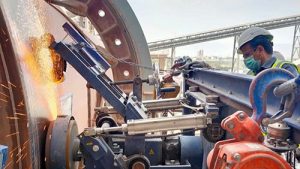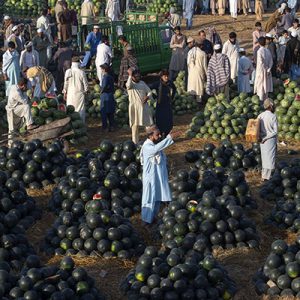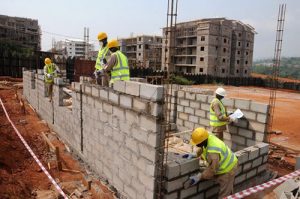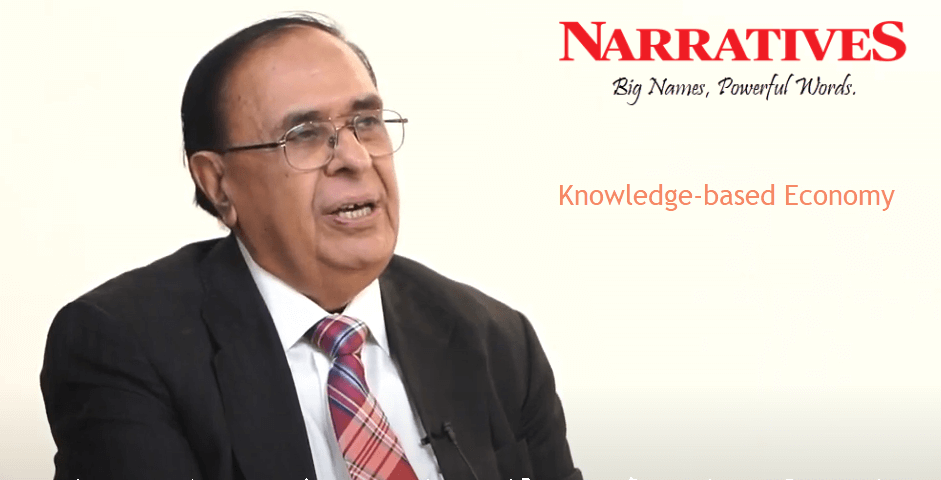The opposition parties may be working overtime to paint a picture of doom and gloom vis a vis the Pakistani economy, but in recent months there has been a sharp surge in economic activity, many businesses are booming and the macro-economic numbers are showing signs of a healthy revival.
“Some of my businessmen friends smile to themselves while walking… they don’t know how to keep count of their profits,” says a Karachi-based business tycoon, who himself has stakes in a number of businesses — from real estate, cement and telecoms, to oil and gas.
“Government policies have helped revive all the key sectors,” he said. “Textile, Information Technology, real estate and housing, cement, chemical, manufacturing…. all these sectors are doing well. Most of them are, in fact, undergoing unprecedented expansion.”
The macro-economic numbers and corporate results do substantiate such claims. Beating the predictions of the International Monetary Fund (IMF), the World Bank and even the State Bank of Pakistan (SBP) — which predicted 1.3, 1.5 and 3.0 per cent growth respectively —Pakistan’s economic growth for fiscal 2020/21 (July-June) is being at estimated at around 3.94 per cent, and it is likely to cross the 4.0 per cent mark once the numbers get updated after the close of the financial year.

The other economic numbers the Pakistan Tehreek-e-Insaaf (PTI) government is celebrating include $3.2 billion in exports in March 2021, which is a record in any month for the country. This fiscal year, Pakistan is expecting to cross the elusive $25 billion mark for annual exports, which is already hovering at $21 billion in the first 10 months of the current fiscal year. Textiles are as usual leading Pakistani exports, but the IT Industry has also made its presence felt by raking in more than $1.0 billion in exports.
Pakistan’s foreign exchange reserves are now at $23 billion — the highest since 2016. As a result, the Pakistani rupee has strengthened against the dollar and other currencies — another positive signal for the country’s economy.
Similarly, remittances are also at a record high of $27 billion in the first 11 months of this fiscal year, while after 10 years, Pakistan will be ending its financial year with a surplus of $773 million in its current account.
The Federal Board of Revenue registered an increase of 14 per cent (year-on-year basis) in the first 10 months of fiscal 2020-21… And the list goes on.
Meanwhile, questions remain: what magic wand did Prime Minister Imran Khan wave to get these positive economic figures? More importantly, will this growth momentum be carried forward into the next financial year? And what measures will the government have to take to sustain this growth?
Experts say that the government itself had been responsible for the slow economic growth under the IMF stabilisation programme when it took a series of stringent measures to suppress the demand all through 2019.
The State Bank of Pakistan (SBP) kept the interest rate in double digits — hovering at 13.25 percent — for the greater part of 2019, which discouraged borrowing and made the cost of doing business high. The SBP also allowed a sharp devaluation of the rupee, compounding uncertainty in the market. At the same time, the government also tried to expand the tax base, though without much success. However, all these measures dampened business sentiment and slowed down economic activity. Yet, these measures helped to stave off the looming balance of payment crisis. The government successfully managed to erase the whopping 19 billion dollars current account deficit and bring it into surplus, which could not have been made possible without tightening imports and the overall demand.
Then in 2020, like the other World economies, Pakistan too had to face the challenge of COVID-19, which kept economic activity low. It meant that there was a two-year pent-up demand, helping in the speedy recovery of economic activity.

On the international front, the pandemic challenge diverted many export orders from China to smaller economies, including Pakistan. These export orders from the developed countries are likely to be there in the years to come as many buyers are diversifying imports to keep steady supplies rather than banking on only China.
The bottom line, there have been many policy initiatives by the government which helped first to stabilise the economy, and then to boost economic activity and growth.
So while a few sectors, such as hospitality and catering among others, do remain in the red, more than 96 per cent of the sectors are working to their capacity, and many are feverishly expanding, including textiles, creating both jobs and higher wages for employees.
Prime Minister Imran Khan’s decision not to go for a complete lockdown during the initial days of Coronavirus in 2020 proved to be a major saviour for the economy. At that time there was a lot of pressure from every quarter — civil society, the opposition, experts, the media and even within the government itself — to slap a complete lockdown. But Khan decided that in a developing country like Pakistan, the wheels of industry and the economy must be allowed to keep moving in the larger interest of the common man. This helped Pakistan avoid the panic situation witnessed in neighbouring India, kept supplies at home steady, and ensured economic activity under the challenging circumstances.

The targeted subsidy to the poor during the pandemic and the expansion of the Ehsaas Programme also created a magic of their own, keeping demand alive in the market.
The slashing down of the interest rate to 7.0 percent from 13.25 last year —proved the first major step to pave the way for the economic revival. The SBP was also quick to launch the Temporary Economic Refinance Facility for new investments and expansions and ensured that cheap loans were made available at 3.0 to 3.5 per cent to investors. These steps were followed by the Roshan Digital Account (RDA) for the Pakistani diaspora community settled abroad. This initiative has really taken off, attracting more than $1.0 billion since its launch. Given the ever-increasing awareness and popularity of the Roshan Digital Account, this is likely to prove to be a key source of flows to strengthen the country’s foreign exchange position and the flows under this scheme are likely to hit $3.0 billion by December 21.
Pakistan also returned to the global bond market for the first time since 2017, raising $2.5bn through the issue of Eurobonds. Pakistan is now planning to issue a ‘Green’ bond in the coming months.
The Agriculture Package worth Rs. 50 billion, the SME (small and medium enterprises) support package under which electricity rates were slashed, incremental energy consumption at a 25 to 50 per cent discount for industry/SMEs all helped boost economic activity and creating a positive sentiment.
Among these initiatives, one big ticket item proved to be the Construction Sector Package under which to-date more than 1,000 projects have been registered, worth Rs. 355 billion. The government also announced a Rs. 30 billion subsidy for its flagship Naya Pakistan Housing Scheme, giving the middle and lower-middle classes the means to purchase their own houses and apartments at low interest rates, with their rent outlays covering the loan repayment instalments, making them owners of a residential property.
Incentives to the construction sector have benefited the cement industry and it is now working at more than 80 per cent of its capacity, registering a double-digit growth in its volumes.
Players in the construction industry say that the planned annual construction of 500,000 houses will lead to the resource mobilisation of Rs 2.0 trillion annually. It will generate an additional cement demand of 10 million tonnes and 1.5 million tonnes of steel apart from benefitting more than three dozen allied industries.
These estimates do not incorporate the impact of big-ticket projects, including the ones related to the China Pakistan Economic Corridor and other government initiated infra-structure projects.
The Large-Scale Manufacturing (LSM) sector, which contributes 78 per cent to overall manufacturing, has recorded an 8.99 per cent YoY growth in the first nine months of fiscal 2021. The growth in LSM is driven by non-metallic mineral products (+24.3 per cent), food (+11.7 per cent), and automobiles (+23.38 per cent), which gives credence to Pakistan’s consumerism story and its potentially robust growth in the services sector.

The agriculture sector, the biggest employer and the backbone of the economy, also witnessed a revival. Urea sales have been 36 per cent up in the first nine months of the fiscal year as several key crops gave record yields. High worldwide commodity prices directly benefited the rural population where the purchasing power of the ordinary farmer saw a marked increase.
The government is also taking measures to address the problems of the power sector. However, due to its complexities, it will take time before the country gets out of the vortex of circular debt, and addresses the issues of power distribution, theft and optimum utilisation.
While the economic numbers are telling a positive story, despite all the efforts by the government, the story has yet to catch up with the Pakistani common man, who is bombarded by opposition propaganda and negative media coverage, where a bad story appears to sell better than a straightforward positive one.
However, the increase in economic activity is being reflected in the remunerations of skilled and semi-skilled workers. According to the government figures, there has been an increase of 17.44 per cent to up to 29.21 per cent in the earnings of daily wage workers. From painters to masons, unskilled labourers to plumbers and electricians — all have benefited from the rise in their daily wages. In the textile sector too there has been expansion, new job creation and an increase in salaries. But the politics of confrontation and an irresponsible media is not allowing the positive news with regard to the Pakistani economy to come to the forefront and create a ripple effect.
This does not mean that the PTI government’s scorecard is positive in every aspect. While economic activity has surged, the government has yet to go for reforms to revive assorted moribund state-run enterprises which are a drain on the country’s resources.
After many slips, however, as it enters the final leg of its term in office, the PTI government appears at a point where it can change the economic story of Pakistan and eye another term based on its economic performance. Prime Minister Imran Khan inherited an economy in the red, and since day one of his assuming power it was a given that the management of the economy would be a make or break for his government.
The latest economic numbers show that now Imran Khan has a fair chance to consolidate his innings. But it is still too early to declare outright victory as the match is still at a crucial stage.

The writer is a senior journalist and managing editor, Narratives.



